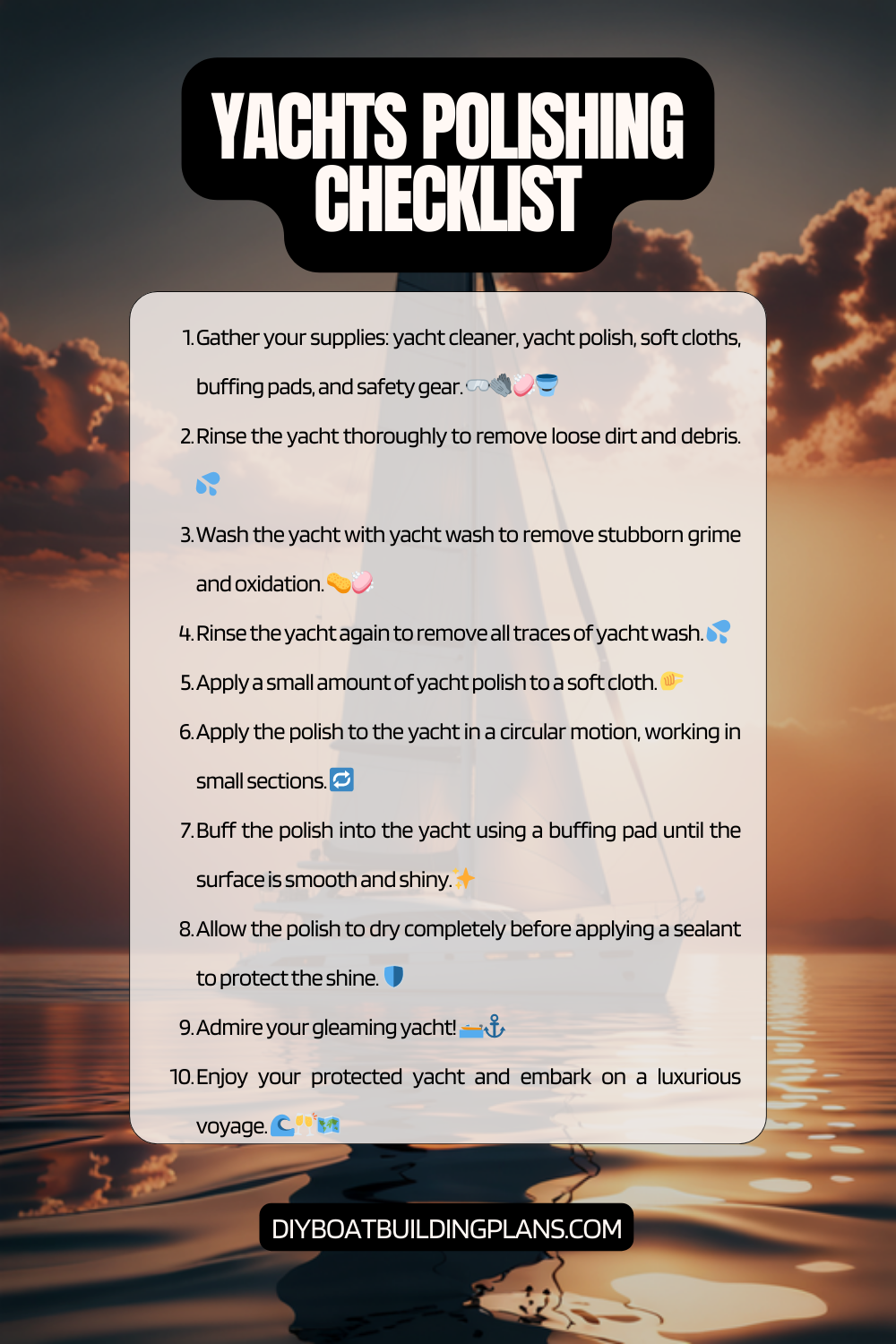Overview of Yacht Polishing Tips
Yacht polishing refers to the process of restoring and maintaining the shine and luster of a yacht’s surface. It involves using specialized products and techniques to remove oxidation, stains, and scratches, and to protect the yacht from environmental factors. Yacht polishing is an essential part of yacht maintenance, as it not only enhances the appearance of the yacht but also helps to prolong its lifespan.
Maintaining a yacht is crucial for several reasons. Firstly, a well-maintained yacht retains its value over time. Regular polishing helps to prevent the deterioration of the yacht’s surface, ensuring that it remains in top condition. Secondly, yacht polishing protects the yacht from environmental factors such as UV rays, saltwater, and pollutants. These elements can cause damage to the yacht’s surface, leading to discoloration, fading, and corrosion. Lastly, yacht polishing enhances the overall appearance of the yacht. A polished yacht looks sleek and luxurious, making it more appealing to potential buyers or charter clients.
Key Takeaways
- Regular yacht polishing is important to maintain the appearance and value of your vessel.
- Choosing the right polishing products and preparing the yacht properly are crucial for achieving a high gloss finish.
- Different polishing techniques should be used for different surfaces, such as fiberglass, metal, and wood.
- Maintaining the polished surface requires regular cleaning and touch-ups.
- Yacht polishing can be a time-consuming process, but the results are worth it for a beautiful and well-maintained vessel.

Importance of Regular Yacht Polishing
Regular yacht polishing is essential for the long-term protection of your investment. By regularly polishing your yacht, you can protect it from environmental factors that can cause damage to its surface. UV rays from the sun can fade and oxidize the paint or gel coat on your yacht, making it look dull and worn out. Saltwater can also corrode metal surfaces and cause discoloration. By regularly polishing your yacht, you create a protective barrier that shields it from these harmful elements.
In addition to protecting your yacht from environmental factors, regular polishing also helps prevent damage to its surface. Over time, dirt, grime, and other contaminants can accumulate on your yacht’s surface, causing scratches and abrasions. By regularly polishing your yacht, you can remove these contaminants and prevent them from causing further damage. Polishing also helps to smooth out any imperfections on the surface, giving your yacht a flawless finish.
Furthermore, regular yacht polishing enhances the appearance of your vessel. A polished yacht looks sleek and well-maintained, making it stand out from the crowd. Whether you are cruising the open seas or showcasing your yacht at a marina, a polished surface will make a lasting impression on anyone who sees it. The glossy finish reflects light, giving your yacht a luxurious and glamorous look.
Choosing the Right Polishing Products
When it comes to choosing the right polishing products for your yacht, there are several factors to consider. Firstly, you need to determine the type of surface you will be polishing. Different surfaces require different products and techniques. For example, fiberglass yachts require specific polishing products that are designed to restore and protect the gel coat. Metal yachts, on the other hand, require products that can remove oxidation and restore shine without causing damage.
Another factor to consider is the condition of your yacht’s surface. If your yacht has deep scratches or stains, you may need more aggressive polishing products to remove them. However, if your yacht’s surface is in relatively good condition, you can opt for milder polishing products that focus on enhancing shine and protecting against future damage.
It is also important to choose polishing products that are safe for the environment. Look for products that are biodegradable and do not contain harmful chemicals that can pollute the waterways. Additionally, consider the ease of use and application of the products. Some products may require multiple steps or specialized equipment, while others may offer a more straightforward application process.
Recommended polishing products include marine-grade compounds and polishes that are specifically formulated for yachts. These products are designed to remove oxidation, stains, and scratches while providing long-lasting protection against UV rays and saltwater. Some popular brands include 3M Marine Restorer and Wax, Meguiar’s Marine/RV One-Step Compound, and Collinite Fiberglass Boat Wax.
Preparing the Yacht for Polishing
| Task | Time Required | Materials Needed | Tools Required |
| Wash the yacht | 2 hours | Soap, water, sponge, bucket | Hose, ladder |
| Remove rust stains | 1 hour | Rust remover, scrub brush | Gloves, safety glasses |
| Apply rubbing compound | 3 hours | Compound, applicator pad | Buffer, polishing pad |
| Polish the yacht | 4 hours | Polish, microfiber cloth | Buffer, polishing pad |
Before you begin the polishing process, it is essential to prepare your yacht’s surface properly. This involves cleaning the surface, removing stains and scratches, and ensuring that the surface is dry and free from any contaminants.
Start by thoroughly cleaning the yacht’s surface using a mild detergent or boat soap. Use a soft brush or sponge to gently scrub away any dirt, grime, or salt residue. Pay special attention to hard-to-reach areas and crevices where dirt can accumulate. Rinse the surface with clean water to remove any soap residue.
Next, inspect the surface for any stains or scratches. Stains can be removed using specialized stain removers or by gently sanding the affected area with fine-grit sandpaper. Scratches can be buffed out using a compound or polish specifically designed for the type of surface you are working on. Follow the manufacturer’s instructions for best results.
Once the surface is clean and free from stains and scratches, ensure that it is completely dry before proceeding with the polishing process. Use a clean microfiber cloth or chamois to remove any remaining moisture. Moisture can interfere with the effectiveness of the polishing products and may cause streaks or water spots on the surface.
Polishing Techniques for Different Surfaces
Different surfaces require different polishing techniques to achieve optimal results. Whether you have a fiberglass, metal, or wooden yacht, understanding the appropriate techniques will help you achieve a high gloss finish.
For fiberglass yachts, start by applying a marine-grade compound using a rotary buffer or polisher. Work in small sections, applying moderate pressure and moving in circular motions. This will help to remove oxidation and restore shine to the gel coat. Once the compound has been applied, switch to a foam pad and apply a marine-grade polish in the same manner. This will further enhance shine and provide long-lasting protection.
Metal yachts require a slightly different approach. Start by using a metal cleaner or polish to remove oxidation and restore shine. Apply the product using a soft cloth or applicator pad, working in small sections. Use gentle, circular motions to ensure even coverage. Once the metal surface is clean and shiny, apply a metal sealant or wax to provide long-lasting protection against corrosion and discoloration.
Wooden yachts require a more delicate approach to avoid damaging the wood. Start by sanding the surface with fine-grit sandpaper to remove any imperfections or roughness. Once the surface is smooth, apply a wood cleaner or brightener to remove any stains or discoloration. Follow this with a wood polish or oil to enhance the natural beauty of the wood and provide protection against UV rays and moisture.
Polishing Fiberglass Yachts
When it comes to polishing fiberglass yachts, there are specific steps you should follow to achieve the best results. Begin by thoroughly cleaning the yacht’s surface using a mild detergent or boat soap. Rinse the surface with clean water and allow it to dry completely.
Once the surface is dry, apply a marine-grade compound using a rotary buffer or polisher. Work in small sections, applying moderate pressure and moving in circular motions. This will help to remove oxidation and restore shine to the gel coat. Continue this process until the entire surface has been treated.
After applying the compound, switch to a foam pad and apply a marine-grade polish in the same manner. This will further enhance shine and provide long-lasting protection against UV rays and saltwater. Work in small sections, applying moderate pressure and moving in circular motions. Continue this process until the entire surface has been treated.
Finally, use a clean microfiber cloth or buffing pad to remove any excess polish residue and buff the surface to a high gloss finish. Take care not to apply too much pressure, as this can cause swirl marks or damage the gel coat. Step back and admire the beautiful shine you have achieved on your fiberglass yacht.
Polishing Metal Yachts
Polishing metal yachts requires a different approach compared to fiberglass yachts. Start by thoroughly cleaning the metal surface using a metal cleaner or polish. Apply the product using a soft cloth or applicator pad, working in small sections. Use gentle, circular motions to ensure even coverage.
Once the metal surface is clean and shiny, apply a metal sealant or wax to provide long-lasting protection against corrosion and discoloration. Apply the sealant or wax using a clean cloth or applicator pad, working in small sections. Allow the product to dry according to the manufacturer’s instructions before buffing it off with a clean microfiber cloth.
Regular maintenance is key to keeping your metal yacht looking its best. Regularly wash the surface with mild soap and water to remove any dirt or salt residue. Avoid using abrasive cleaners or scrub brushes that can scratch the metal surface. Additionally, apply a fresh coat of sealant or wax every few months to maintain the protective barrier and keep your metal yacht looking shiny and new.
Polishing Wooden Yachts
Polishing wooden yachts requires a gentle touch to avoid damaging the wood. Start by sanding the surface with fine-grit sandpaper to remove any imperfections or roughness. Sand in the direction of the wood grain to avoid creating scratches.
Once the surface is smooth, apply a wood cleaner or brightener to remove any stains or discoloration. Follow the manufacturer’s instructions for best results. After applying the cleaner or brightener, rinse the surface with clean water and allow it to dry completely.
Once the wood surface is dry, apply a wood polish or oil using a clean cloth or applicator pad. Work in small sections, applying moderate pressure and moving in the direction of the wood grain. This will help to enhance the natural beauty of the wood and provide protection against UV rays and moisture.
Regular maintenance is essential for wooden yachts to prevent damage and maintain their appearance. Avoid exposing the wood to direct sunlight for extended periods, as this can cause fading and drying. Regularly clean the surface with a mild soap and water solution, and apply a fresh coat of wood polish or oil every few months to keep the wood looking its best.
Tips for Achieving a High Gloss Finish
Achieving a high gloss finish requires attention to detail and the use of proper techniques. Here are some tips to help you achieve the best results when polishing your yacht:
1. Use the right polishing products: Choose products that are specifically designed for your yacht’s surface. Using the wrong products can lead to ineffective results or even damage.
2. Apply the right amount of pressure: Applying too much pressure can cause swirl marks or damage the surface, while applying too little pressure may not yield the desired results. Find a balance and apply moderate pressure when polishing.
3. Polish in the right direction: Always polish in the direction of the surface’s grain or pattern. This will help to avoid creating scratches or swirl marks.
4. Work in small sections: Polishing in small sections allows you to focus on one area at a time, ensuring even coverage and preventing the product from drying out before it can be properly buffed off.
5. Take breaks: Polishing can be a time-consuming process, especially for larger yachts. Take breaks to rest your arms and avoid fatigue, as this can affect your technique and result in uneven polishing.
Download over 500 Boat Plans. Click on the link below.
-->Click Here<--
Maintaining the Polished Surface
Once you have achieved a high gloss finish on your yacht, it is important to maintain it to ensure long-lasting results. Regular cleaning is key to keeping your yacht’s surface looking its best. Use a mild soap or boat cleaner and a soft brush or sponge to remove dirt, grime, and salt residue. Rinse the surface with clean water and dry it thoroughly to prevent water spots.
Avoid exposing your yacht to harsh environmental factors that can damage the polished surface. If possible, store your yacht in a covered area or use a boat cover when it is not in use. This will protect it from UV rays, rain, and other elements that can cause fading or corrosion.
Inevitably, scratches and stains may occur on your yacht’s surface over time. To touch up these imperfections, use a mild compound or polish specifically designed for your yacht’s surface. Apply the product using a soft cloth or applicator pad, working in small sections. Buff the area gently until the imperfection is no longer visible.
Yacht Polishing Checklist

Conclusion – Yacht Polishing Tips
In conclusion, yacht polishing is an essential part of yacht maintenance that helps to protect your investment and enhance its appearance. Regular polishing not only protects your yacht from environmental factors but also prevents damage to its surface and prolongs its lifespan. By choosing the right polishing products and following the appropriate techniques for your yacht’s surface, you can achieve a high gloss finish that will make your yacht stand out from the crowd.
Remember to regularly clean your yacht’s surface, avoid harsh environmental factors, and touch up any scratches or stains to maintain the polished finish. With proper care and maintenance, your yacht will continue to shine for years to come. So, invest the time and effort into yacht polishing, and enjoy the beauty and luxury of your vessel on every voyage.
FAQs – Yacht Polishing Tips
What is yacht polishing?
Yacht polishing is the process of removing scratches, oxidation, and other imperfections from the surface of a yacht to restore its shine and protect it from further damage.
Why is yacht polishing important?
Yacht polishing is important because it helps to maintain the appearance and value of a yacht. It also helps to protect the surface from damage caused by exposure to the elements, such as UV rays, saltwater, and pollution.
What are some tips for yacht polishing?
Some tips for yacht polishing include using the right tools and products, working in small sections, applying even pressure, and using a clean microfiber cloth to buff the surface.
What tools and products are needed for yacht polishing?
Tools and products needed for yacht polishing include a polishing machine, polishing pads, polishing compound, wax, and a microfiber cloth.
How often should a yacht be polished?
The frequency of yacht polishing depends on a variety of factors, such as the age of the yacht, the condition of the surface, and the amount of use it receives. Generally, it is recommended to polish a yacht at least once a year, but it may need to be done more frequently if it is exposed to harsh conditions.
Can yacht polishing be done by a DIYer?
Yes, yacht polishing can be done by a DIYer, but it requires some knowledge and skill to do it properly. It is important to follow the manufacturer’s instructions for the tools and products used, and to work carefully to avoid causing damage to the surface.



